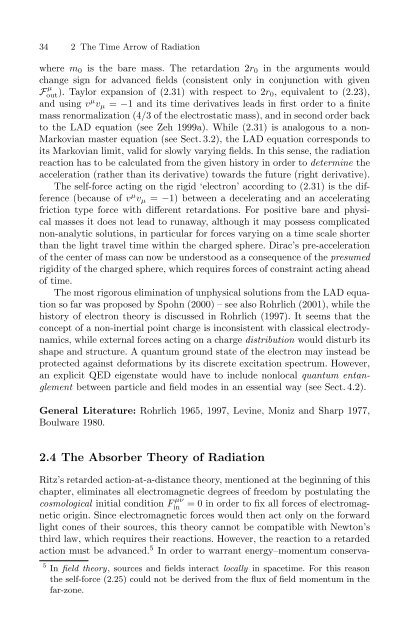The Physical Basis of The Direction of Time (The Frontiers ...
The Physical Basis of The Direction of Time (The Frontiers ...
The Physical Basis of The Direction of Time (The Frontiers ...
You also want an ePaper? Increase the reach of your titles
YUMPU automatically turns print PDFs into web optimized ePapers that Google loves.
34 2 <strong>The</strong> <strong>Time</strong> Arrow <strong>of</strong> Radiation<br />
where m 0 is the bare mass. <strong>The</strong> retardation 2r 0 in the arguments would<br />
change sign for advanced fields (consistent only in conjunction with given<br />
F µ out). Taylor expansion <strong>of</strong> (2.31) with respect to 2r 0 , equivalent to (2.23),<br />
and using v µ v µ = −1 and its time derivatives leads in first order to a finite<br />
mass renormalization (4/3 <strong>of</strong> the electrostatic mass), and in second order back<br />
to the LAD equation (see Zeh 1999a). While (2.31) is analogous to a non-<br />
Markovian master equation (see Sect. 3.2), the LAD equation corresponds to<br />
its Markovian limit, valid for slowly varying fields. In this sense, the radiation<br />
reaction has to be calculated from the given history in order to determine the<br />
acceleration (rather than its derivative) towards the future (right derivative).<br />
<strong>The</strong> self-force acting on the rigid ‘electron’ according to (2.31) is the difference<br />
(because <strong>of</strong> v µ v µ = −1) between a decelerating and an accelerating<br />
friction type force with different retardations. For positive bare and physical<br />
masses it does not lead to runaway, although it may possess complicated<br />
non-analytic solutions, in particular for forces varying on a time scale shorter<br />
than the light travel time within the charged sphere. Dirac’s pre-acceleration<br />
<strong>of</strong> the center <strong>of</strong> mass can now be understood as a consequence <strong>of</strong> the presumed<br />
rigidity <strong>of</strong> the charged sphere, which requires forces <strong>of</strong> constraint acting ahead<br />
<strong>of</strong> time.<br />
<strong>The</strong> most rigorous elimination <strong>of</strong> unphysical solutions from the LAD equation<br />
so far was proposed by Spohn (2000) – see also Rohrlich (2001), while the<br />
history <strong>of</strong> electron theory is discussed in Rohrlich (1997). It seems that the<br />
concept <strong>of</strong> a non-inertial point charge is inconsistent with classical electrodynamics,<br />
while external forces acting on a charge distribution would disturb its<br />
shape and structure. A quantum ground state <strong>of</strong> the electron may instead be<br />
protected against deformations by its discrete excitation spectrum. However,<br />
an explicit QED eigenstate would have to include nonlocal quantum entanglement<br />
between particle and field modes in an essential way (see Sect. 4.2).<br />
General Literature: Rohrlich 1965, 1997, Levine, Moniz and Sharp 1977,<br />
Boulware 1980.<br />
2.4 <strong>The</strong> Absorber <strong>The</strong>ory <strong>of</strong> Radiation<br />
Ritz’s retarded action-at-a-distance theory, mentioned at the beginning <strong>of</strong> this<br />
chapter, eliminates all electromagnetic degrees <strong>of</strong> freedom by postulating the<br />
cosmological initial condition F µν<br />
in<br />
= 0 in order to fix all forces <strong>of</strong> electromagnetic<br />
origin. Since electromagnetic forces would then act only on the forward<br />
light cones <strong>of</strong> their sources, this theory cannot be compatible with Newton’s<br />
third law, which requires their reactions. However, the reaction to a retarded<br />
action must be advanced. 5 In order to warrant energy–momentum conserva-<br />
5 In field theory, sources and fields interact locally in spacetime. For this reason<br />
the self-force (2.25) could not be derived from the flux <strong>of</strong> field momentum in the<br />
far-zone.



![arXiv:1001.0993v1 [hep-ph] 6 Jan 2010](https://img.yumpu.com/51282177/1/190x245/arxiv10010993v1-hep-ph-6-jan-2010.jpg?quality=85)


![arXiv:1008.3907v2 [astro-ph.CO] 1 Nov 2011](https://img.yumpu.com/48909562/1/190x245/arxiv10083907v2-astro-phco-1-nov-2011.jpg?quality=85)








![arXiv:1002.4928v1 [gr-qc] 26 Feb 2010](https://img.yumpu.com/41209516/1/190x245/arxiv10024928v1-gr-qc-26-feb-2010.jpg?quality=85)
![arXiv:1206.2653v1 [astro-ph.CO] 12 Jun 2012](https://img.yumpu.com/39510078/1/190x245/arxiv12062653v1-astro-phco-12-jun-2012.jpg?quality=85)
